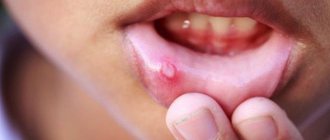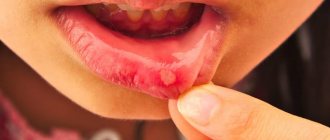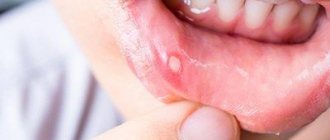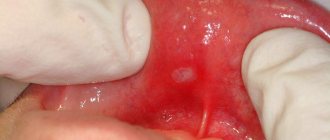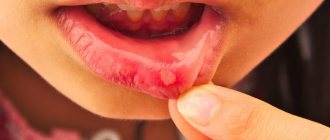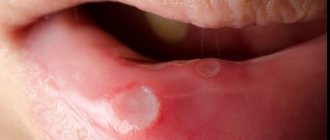Causes of stomatitis
Stomatitis can occur as an independent disease or as one of the manifestations of general diseases and pathologies of internal organs1.
Among the causes of stomatitis:
- injuries to the oral mucosa: - mechanical, thermal, chemical7;
- diseases of the gastrointestinal tract, for example, gastritis, peptic ulcer of the stomach and duodenum, enteritis, colitis7;
- general bacterial and viral infections - inflammation of the mucous membrane accompanies measles, scarlet fever, diphtheria, in this case the symptoms of stomatitis are accompanied by a sore throat associated with damage to the tissues of the pharynx7;
- blood diseases - leukemia, lymphocytic leukemia, leukemia, agranulocytosis;
- cardiovascular pathology accompanied by circulatory failure;
- diabetes;
- systemic diseases of connective tissue - collagenosis;
- helminthic infestations1,5,8.
Specific stomatitis occurs after toxic and radiation exposure to the body, as well as with syphilis and HIV infection1,5,7,8.
Up to contents
Home medicine
If stomatitis appears on the tonsils, how can it be treated without a doctor? Therapy can be carried out using folk remedies and well-known methods. Some of them turn out to be very effective, so they are used from generation to generation:
- rinsing with soda - disinfects, relieves inflammation and promotes healing; lubrication with aloe juice - inhibits the growth of microorganisms, creates a protective film; spot compresses from crushed garlic - a natural antibiotic; rinsing the mouth with cabbage and carrot juice - increases immunity and promotes the healing of ulcers.
If stomatitis appears on the tonsils in children (photos of ulcers are provided for your visual reference), then you should not resort to self-medication. Be sure to show your child to the doctor.
Types of stomatitis
Due to the variety of types of inflammation of the mucous membrane, it is impossible to describe them all within the framework of the article. The most common forms of the disease are:
- catarrhal;
- ulcerative;
- aphthous: acute and chronic.1,4,8
Catarrhal stomatitis
Catarrhal stomatitis develops most often with violation of the rules of oral hygiene, a large amount of soft and hard dental plaque, and the use of dental prostheses1,4,6.
What does catarrhal stomatitis look like?
The mucous membrane of the oral cavity, gums and gingival papillae, the mucous membrane of the inner surface of the cheeks, as well as the tongue and palate are red, swollen, covered with a white coating, which can then turn brown. Eating causes pain, the mucous membrane begins to bleed at the slightest irritation1.
With simple catarrhal inflammation, only the superficial layer of the oral mucosa is affected, so this stomatitis is quite easy to treat. If stomatitis does not go away, this is a reason to examine the gastrointestinal tract1,4.
Ulcerative stomatitis
Ulcerative stomatitis can develop as a complication of catarrhal disease or as a separate pathology. Most often it occurs against the background of gastric and duodenal ulcers, chronic enteritis, sometimes with diseases of the cardiovascular system, and general infections1,4,5,6.
In the ulcerative form of stomatitis, the entire thickness of the mucous membrane is affected4. Initially, areas of redness and swelling appear on it (usually under the tongue and on the buccal surface). There is a burning sensation in the mouth, which intensifies when eating4,5. On the 2-3rd day of the disease, a dirty gray plaque forms at the site of the lesion, and after its rejection, painful ulcers appear1,5.
Ulcers can be single or multiple, sometimes they merge with each other and form extensive ulcerated areas. The volume of the lesion determines the severity of the disease. Thus, with severe inflammation, symptoms of general intoxication are observed: weakness, increased fatigue, headache, fever up to 37.50 C1,4,5,6.
In addition to the listed symptoms, with ulcerative stomatitis, the lymph nodes under the lower jaw and on the anterolateral surface of the neck enlarge4,5,6. Saliva becomes viscous, viscous, the smell from the mouth becomes fetid, putrefactive1.5.
How many days does ulcerative stomatitis last? Proper treatment started in a timely manner promotes healing of ulcers within 8-10 days. If you do nothing and wait until the stomatitis goes away on its own, the inflammation can spread deeper and involve the jaw bones - osteomyelitis will develop1,5.
Aphthous stomatitis
Aphthous stomatitis is characterized by the formation of single or multiple aphthous stomatitis on the oral mucosa1,2,3,4,6.
Aphthae are round-shaped formations, the size of a lentil grain, with a grayish-yellowish coating in the center and a narrow rim of redness along the periphery4,6,9. After the plaque is rejected, a small and extremely painful ulcer forms in the center of the aphthae, which, when healing, turns into a red spot. This spot lasts only a few days and then disappears without a trace1,3,9.
Aphthous inflammation can occur in acute and chronic forms1,2. In acute cases, the appearance of aphthae during stomatitis is accompanied by pain in the mouth, weakness, weakness, and increased body temperature4. As the rash disappears during treatment of stomatitis, the condition quickly improves - recovery is observed1,3.
With chronic aphthous inflammation, there are no general symptoms, and the number of emerging aphthae is limited to 1-3. The disease exists for many years, worsening mainly in spring and autumn1,2,3.
How long does aphthous stomatitis last? With proper treatment, its manifestations disappear within 7-10 days1,2,3. Acute forms of pathology may never recur, and chronic inflammation may not bother you for a long time or, conversely, worsen with the slightest decrease in immunity1,2,3,9.
Up to contents
Possible complications and prevention
Severe herpes sore throat can lead to the spread of infection throughout the body and damage to internal organs - so-called complications arise. The most common complication after suffering herpes sore throat is serous meningitis, or inflammation of the brain. The disease can lead to disturbances in the functioning of the heart and cause myocarditis, which is diagnosed by an electrocardiogram. Kidney diseases (pyelonephritis), liver, hemorrhagic conjunctivitis - this is just an incomplete list of complications with late diagnosis of the disease and delayed treatment. If you have the slightest suspicion of a disease, do not delay visiting a doctor!
To date, no vaccines have been developed to prevent herpangina disease. During an epidemic, if possible, do not take your child to kindergarten or school. Adults should try to avoid places with a lot of people and remember the rules of hygiene. Both children and adults need to strengthen their immune system in general, eat healthy and balanced, take vitamins and harden themselves.
If there is a sick person at home, it is necessary to ventilate the room frequently, and provide the sick person with individual dishes, linen and a towel.
How to get rid of stomatitis
The best decision is to immediately consult a dentist. But if the disease takes you by surprise and medical help is temporarily unavailable, you should not be inactive.
Rinsing and irrigating the mouth with special preparations, such as HEXORAL®10,11, will help combat the symptoms of stomatitis.
HEXORAL® spray can be recommended for children over 3 years of age who do not yet know how to gargle independently and can swallow the solution. The drug contains hexetidine, a broad-spectrum antiseptic that is active against most bacteria, herpes simplex viruses type 1, influenza A, PC virus that affects the respiratory tract, and fungi. Due to the action of hexethidine and other components, the drug helps reduce pain and bad breath10.
HEXORAL® solution can be used as a mouth rinse. The procedure should be carried out after meals for 30 seconds 2-3 times a day. Hexethidine adheres to the mucous membrane, due to which it continues to act all the time between procedures11.
In addition, for stomatitis, areas of mucosal inflammation can be treated directly with HEXORAL® solution. In this case, the drug must be applied to the affected area using a swab or cotton swab, left for 2-3 minutes and then rinsed out. In some cases, this speeds up recovery11.
For stomatitis, HEXORAL® lozenges can also be used:
- HEXORAL® TABS based on chlorhexidine and benzocaine, which has an antiseptic and analgesic effect, approved for use by adults and children over 4 years of age12.
- HEXORAL® TABS CLASSIC with lemon, orange, blackcurrant, lemon and honey flavors for adults and children aged 6 years and older. The tablets are based on a combination of the antiseptics amylmetacresol and dichlorobenzyl alcohol13.
- HEXORAL® TABS EXTRA, which can be used for the symptomatic treatment of stomatitis in adults and children over 12 years of age. In addition to the antiseptic, it contains the anesthetic lidocaine, which can relieve even severe pain in the mouth14.
Important! Using the drug HEXORAL® does not replace visiting a dentist. Thus, for ulcerative and aphthous inflammatory processes, in addition to local treatment, general therapy may be required: antibiotics, antiallergic drugs, etc. In addition, dental treatment may be indicated to prevent stomatitis1.
The information in this article is for reference only and does not replace professional advice from a doctor. To make a diagnosis and prescribe treatment, consult a qualified specialist.
Up to contents
Diagnosis of pathology
A doctor can assess why stomatitis appears on the tonsil and make the correct diagnosis during a routine examination. No additional manipulations or analyzes are usually required.
For each type of disease, appropriate therapy is used. If you want to get rid of the pathology quickly and correctly, you should consult a doctor. When diagnosing the disease, the following factors are taken into account:
- age and lifestyle of the patient; presence of additional stimulants of the disease; localization and area of rashes; additional symptoms in the form of fever, runny nose, enlarged tonsils, chronic diseases.
What to do if you suddenly notice a white ulcer on your tonsil? Many patients will suspect a sore throat.
But they will not always be right. Treatment of stomatitis and tonsillitis differs significantly. This is why it is so important to make a correct diagnosis.
Therapy of the disease consists of the use of symptomatic remedies that alleviate the patient’s discomfort and the use of medications that affect the cause of the disease. Folk recipes and grandmother’s methods of treating stomatitis are also very popular. Let's look at effective options in more detail.
Literature
- Bazhanov N. N. Dentistry: Textbook, 6th ed., revised. and additional - M.: GEOTAR-MED, 2002. - P. 96-102 - ISBN 5-9231-0272-2.
- Bulkina N.V., Lomakina D.O., Meleshina O.V. Chronic recurrent aphthous stomatitis: features of the clinical course and complex treatment // Saratov Journal of Medical Scientific Research. - 2011. - T. 7. - No. 1 (appendix). — P. 281-282.
- Galizina O.A. Main aspects of the occurrence, clinical manifestations, treatment and prevention of chronic recurrent aphthous stomatitis. CLINICAL STUDIES // RUSSIAN DENTAL JOURNAL, No. 6, 2014. - pp. 39-42
- O.A. Zorina, N.B. Petrukhina, L.M. Kozlova. Treatment of aphthous stomatitis in adolescents // Pediatric pharmacology. 2014; 11(3). — P. 85–88.
- Lutskaya I.K. Ulcerative-necrotic stomatitis in adults and children: diagnosis, treatment and prevention // Modern dentistry. – 2018. – No. 2. – pp. 17–20.
- Belousova O.V., Belousov E.A., Dorokhova N.N. Application of pharmacoeconomic methods to optimize the procurement of drugs for the treatment of stomatitis in a pharmacy // Scientific result. Medicine and pharmacy. – T.3, No. 1, 2021. – P. 48-55.
- Mavrutenkov V.V. Viral stomatitis // Child's Health, No. 3 (63), 2015. - P. 63-68.
- K. G. Karakov Fungal, viral and traumatic stomatitis in the clinic of therapeutic dentistry // Textbook / 2013. – 100 s. /ISBN 978-5-89822-345-8
- Volkov E.A., Butova V.G., Pozdnyakova T.I., Dzugaeva I.I. Clinical recommendations (treatment protocol) for chronic recurrent aphthous stomatitis. // Russian Dental Journal, No. 5, 2014 p. 35-48/UDC 616.31-002.157.2-036.12-08
- Instructions for use of the drug HEXORAL® aerosol // Reg. number P N014010/01 // .
- Instructions for use of the drug HEXORAL® solution: , .
- Instructions for use of the drug HEXORAL® TABS // Reg. number LSR-002626/07 // .
- Instructions for use of the drug HEXORAL® TABS CLASSIC // Reg. number P N015976/01 // .
- Instructions for use of the drug HEXORAL® TABS EXTRA // Reg. number LSR-004122/09 // .


